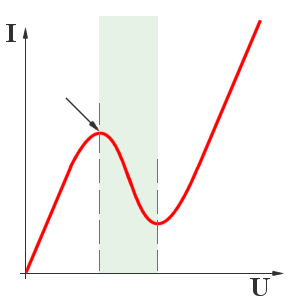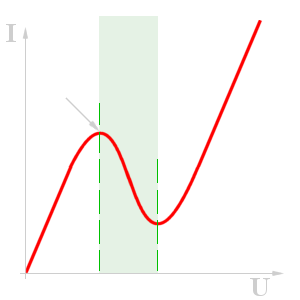“Gunn”- Diode

voltage
resistance
region
Figure 1: Characteristic curve for a bulk-effect semiconductor

voltage
resistance
region
Figure 1: Characteristic curve for a bulk-effect semiconductor
The discovery that microwaves could be generated by applying a steady voltage across a chip of n-type gallium-arsenide (GaAs) crystal was made in 1963 by J.B. Gunn.
The Gunn oscillator is a source of microwave energy that uses the bulk-effect, gallium-arsenide semiconductor. The basic frequency of a gunn oscillator is inversely proportional to the transit time of a domain across the semiconductor. The transit time is proportional to the length of semiconductor material, and to some extent, the voltage applied. Each domain causes a pulse of current at the output; thus, the output is a frequency determined by the physical length of the semiconductor chip.
In a gallium-arsenide semiconductor, empty electron conduction bands exist that are at a higher energy level than the conduction bands occupied by most of the electrons. Any electrons that do occupy the higher conduction band essentially have no mobility. If an electric field of sufficient intensity is applied to the semiconductor electrons, they will move from the low-energy conduction band to the high-energy conduction band and become essentially immobile. The immobile electrons no longer contribute to the current flow and the applied voltage progressively increases the rate at which the electrons move from the low band to the high band. As the curve in figure 1 shows, the maximum current rate is reached and begins to decrease even though the applied voltage continues to increase. The point at which the current on the curve begins to decrease is called the threshold. This point is the beginning of the negative-resistance region. Negative resistance is caused by electrons moving to the higher conduction band and becoming immobile.
Gunn diodes and IMPATT diodes are similar but not interchangeable. Gunn diodes that are made from gallium arsenide can operate at frequencies up to 200 GHz. A Gunn diode made from gallium nitride can reach 3 THz. Specifications for Gunn diodes include frequency range, minimum power, typical operating voltage, operating current, and packaging. For higher output power, a Gunn diode can be pulsed or stacked. The Gunn oscillator can deliver continuous power up to about 65 milliwatts and pulsed outputs of up to about 200 watts peak.
